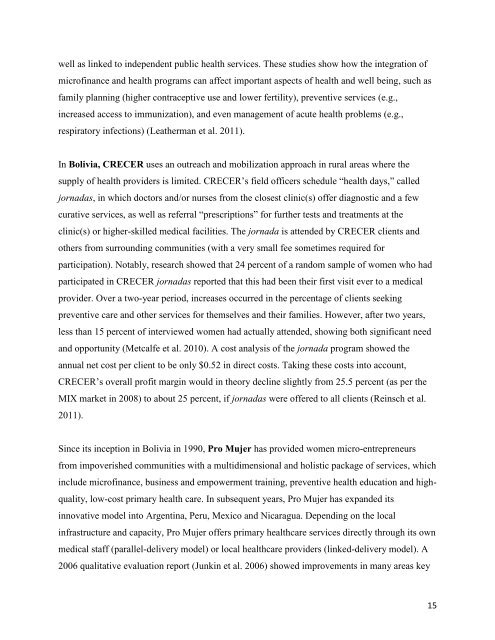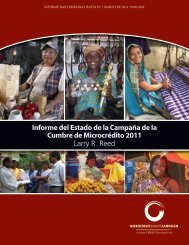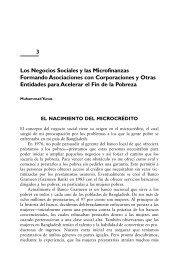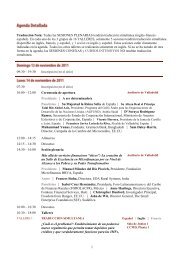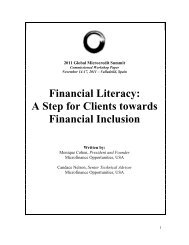Integrating Microfinance and Health - Global Microcredit Summit 2011
Integrating Microfinance and Health - Global Microcredit Summit 2011
Integrating Microfinance and Health - Global Microcredit Summit 2011
Create successful ePaper yourself
Turn your PDF publications into a flip-book with our unique Google optimized e-Paper software.
well as linked to independent public health services. These studies show how the integration ofmicrofinance <strong>and</strong> health programs can affect important aspects of health <strong>and</strong> well being, such asfamily planning (higher contraceptive use <strong>and</strong> lower fertility), preventive services (e.g.,increased access to immunization), <strong>and</strong> even management of acute health problems (e.g.,respiratory infections) (Leatherman et al. <strong>2011</strong>).In Bolivia, CRECER uses an outreach <strong>and</strong> mobilization approach in rural areas where thesupply of health providers is limited. CRECER’s field officers schedule ―health days,‖ calledjornadas, in which doctors <strong>and</strong>/or nurses from the closest clinic(s) offer diagnostic <strong>and</strong> a fewcurative services, as well as referral ―prescriptions‖ for further tests <strong>and</strong> treatments at theclinic(s) or higher-skilled medical facilities. The jornada is attended by CRECER clients <strong>and</strong>others from surrounding communities (with a very small fee sometimes required forparticipation). Notably, research showed that 24 percent of a r<strong>and</strong>om sample of women who hadparticipated in CRECER jornadas reported that this had been their first visit ever to a medicalprovider. Over a two-year period, increases occurred in the percentage of clients seekingpreventive care <strong>and</strong> other services for themselves <strong>and</strong> their families. However, after two years,less than 15 percent of interviewed women had actually attended, showing both significant need<strong>and</strong> opportunity (Metcalfe et al. 2010). A cost analysis of the jornada program showed theannual net cost per client to be only $0.52 in direct costs. Taking these costs into account,CRECER’s overall profit margin would in theory decline slightly from 25.5 percent (as per theMIX market in 2008) to about 25 percent, if jornadas were offered to all clients (Reinsch et al.<strong>2011</strong>).Since its inception in Bolivia in 1990, Pro Mujer has provided women micro-entrepreneursfrom impoverished communities with a multidimensional <strong>and</strong> holistic package of services, whichinclude microfinance, business <strong>and</strong> empowerment training, preventive health education <strong>and</strong> highquality,low-cost primary health care. In subsequent years, Pro Mujer has exp<strong>and</strong>ed itsinnovative model into Argentina, Peru, Mexico <strong>and</strong> Nicaragua. Depending on the localinfrastructure <strong>and</strong> capacity, Pro Mujer offers primary healthcare services directly through its ownmedical staff (parallel-delivery model) or local healthcare providers (linked-delivery model). A2006 qualitative evaluation report (Junkin et al. 2006) showed improvements in many areas key15


